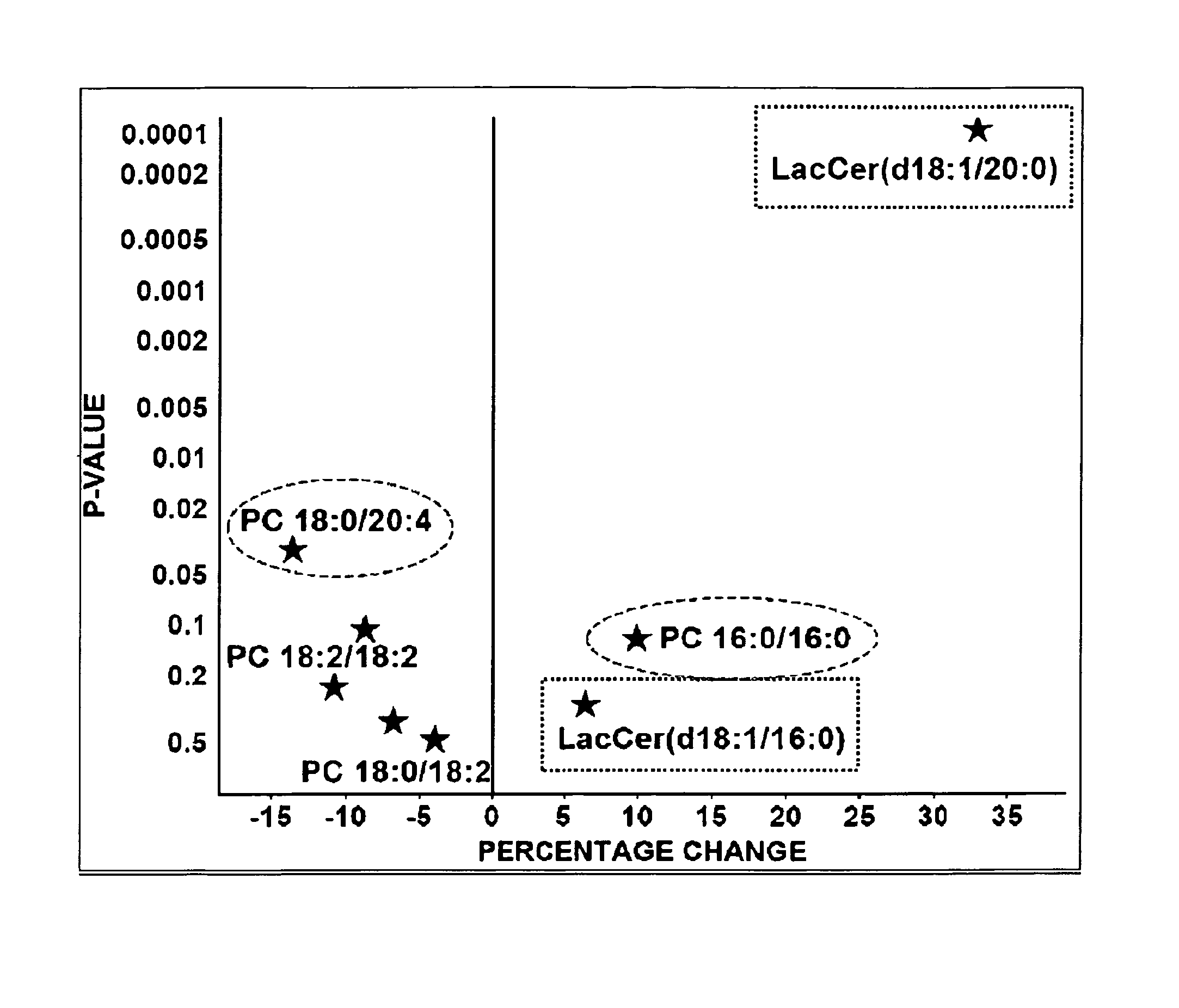Lipidomic Biomarkers for Identification of High-Risk Coronary Artery Disease Patients
a biomarker technology, applied in the field of lipidomic biomarkers for identification of high-risk coronary artery disease patients, can solve the problems that current biomarkers such as ldl-c or hdl-c have only very limited or no value in predicting the death risk of cvd patients, and achieve superior diagnostic and prognostic value, limited effect, and increased or decreased level
- Summary
- Abstract
- Description
- Claims
- Application Information
AI Technical Summary
Benefits of technology
Problems solved by technology
Method used
Image
Examples
example 1
Materials and Methods
[0107]This study is a sub-cohort of the LURIC study that is a large scale prospective study on cardiovascular epidemiology. LURIC database contains clinical information over 3000 patients including baseline coronary angiography, clinically used biomarker data and also e.g. CVD mortality data for the follow-up period (3 years). In this biomarker study the inventors compared CAD cases (n=62) that died during the follow-up due to CVD with patients (n=173) having a stable CAD. Subjects with a significant atherosclerosis level in the angiogram but no CVD related death during the follow-up were used as controls, while the case group had similarly a significant atherosclerosis based on the angiography at baseline and in addition they died during the follow-up due to acute cardiovascular events. A statistical analysis was performed separately also for cases (n=48) and controls (n=124) that were not treated with statins. The clinical characteristics are described in Tabl...
example 2
Analytical Methods
Mass Spectrometry Driven Lipidomics
[0108]Direct infusion coupled to tandem mass spectrometry, i.e. shotgun lipidomics, and two liquid chromatography tandem mass spectrometry (LC-MS / MS) approaches, i.e. ceramide and cerebroside lipidomics, were used to identify lipid biomarkers for coronary artery disease (CVD) risk by analyzing molecular lipid species in human serum, plasma, and carotid artery plaques. The applied methods were optimized especially for quantification of molecular cholesteryl esters (CE), phosphatidylcholines (PC), lysophosphatidylcholines (LPC) and other lysophospholipids (LPL), ether-linked phosphatidylcholines (PC O) and other ether-linked phospholipids (PL O), phosphatidylserines (PS), phosphatidylethanolamines (PE), phosphatidylglycerols (PG), phosphatidylinositols (PI), phosphatidic acids (PA), diacylglycerols (DAG), ceramides (Cer), glucosylceramides (GlcCer) and lactosylceramides (LacCer).
[0109]The following materials were used according to t...
example 3
Ethics
[0125]The LURIC study was approved by the ethics review committee at the “Landesarztekammer Rheinland-Pfalz” (Mainz, Germany). Written informed consent was obtained from each of the participants.
Results
[0126]In this LURIC study sub-cohort, the traditional biomarkers including LDL-cholesterol and HDLcholesterol concentrations were practically identical in both groups and therefore were not predictive of CVD-related mortality in this study.
[0127]Multiple lipidomic markers appeared as significant predictors of CVD death (Tables 4-13). A total of 151 molecular lipids were quantified. The significant predictors were selected based on the top fifty candidates from each category, when available. The biomarker candidates based on molecular lipid concentrations are presented in Tables 4, 7, 10 and 13. The candidates were selected according to the following criteria: t-test p-value ≦0.05 or sensitivity ≧60% and specificity ≧60%. From traditional clinical chemistry only apolipoprotein A1...
PUM
| Property | Measurement | Unit |
|---|---|---|
| Fraction | aaaaa | aaaaa |
| Fraction | aaaaa | aaaaa |
| Fraction | aaaaa | aaaaa |
Abstract
Description
Claims
Application Information
 Login to View More
Login to View More - R&D
- Intellectual Property
- Life Sciences
- Materials
- Tech Scout
- Unparalleled Data Quality
- Higher Quality Content
- 60% Fewer Hallucinations
Browse by: Latest US Patents, China's latest patents, Technical Efficacy Thesaurus, Application Domain, Technology Topic, Popular Technical Reports.
© 2025 PatSnap. All rights reserved.Legal|Privacy policy|Modern Slavery Act Transparency Statement|Sitemap|About US| Contact US: help@patsnap.com

